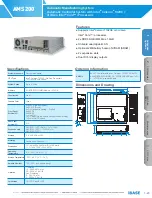
15
Product Manual - Liquid Cylinders
This section provides the filling procedures, operating
pressure information and liquid withdrawal procedures
for Dura-Cyl
®
and Cryo-Cyl
®
Liquid Cylinders The low
pressure (LP), medium pressure (MP) and high pressure (HP)
cylinders have their own sections as procedures differ based
on pressure rating. Filling weight tables are also provided at
the end of each pressure section.
Dura-Cyl
®
LP Liquid Cylinders
The Dura-Cyl LP liquid cylinders are designed to transport,
store and dispense liquid oxygen, nitrogen or argon in
their liquid states only. Liquid product is generally used at
ambient or very low pressures. These liquid cylinders have a
working pressure of 22 psig (1.5 barg) to allow for transfer
into vented cryogenic dewars or equipment. The pressure is
maintained in the liquid cylinder through its normal heat leak
of the cylinder. The pressure will rise in the closed cylinder
as its liquid contents boil off. It is normal for the pressure
to reach the relief valve setting of 22 psi (1.5 bar) and
vent slowly into the atmosphere. The transportation of the
cryogenic products in these liquid cylinders is not regulated
by the DOT/TC since the pressure is normally below 25 psi
(1.7 bar).
Pressure Building (Option)
The LP cylinders are equipped with an internal pressure
building coil and plumbing stubs for the optional PB valve
and regulator. The following procedure should be used for
maintaining pressure during liquid withdrawal if the pressure
building option is part of the Dura-Cyl LP cylinder.
1
Open the PB isolation valve prior to liquid withdrawal.
2
Allow the pressure to rise in the cylinder until the
regulator shuts off the PB circuit
3
Transfer liquid as described in the Filling Procedure
below
4
Close the PB valve when liquid transfer is complete.
Filling Procedure
The Dura-Cyl LP liquid cylinders are equipped with liquid
and vent valves that are used for filling. Use a pressure
transfer fill as the proper filling method for this style of
cylinder. The delivery tank pressure should be as low as
practical for the transfer to be efficient. Follow these steps
for filling LP liquid cylinders:
Operations
Caution! Before making a liquid transfer
be sure that protective
eyeglasses and gloves are being
worn.
1
Sample the residual gas that is in the cylinder. Purge the
cylinder if necessary to ensure the proper purity.
2
Place the cylinder on the filling scale. Record the
weight. Compare this weight to the registered tare
weight on the data plate. The difference is the weight of
the residual gas
3
Connect the transfer hose to the liquid valve Record the
new weight The difference between this weight and the
initial weight is the weight of the transfer hose
4
To determine the total filling weight add the tare weight
of the cylinder, the hose weight and the proper filling
weight from the filling table (i.e. Dura-Cyl 120 LP for
oxygen at 22 psi / 1.5 bar has a product weight of 285
pounds / 129 kg).
5
Open the cylinder vent and liquid valves. Open the
transfer line shut-off valve to begin the flow of product.
6
When the scale reads the calculated total filling weight
turn off the liquid valve on the cylinder Close the vent
valve
7
Close the transfer line shut-off valve and relieve the
pressure in the transfer line. Remove the transfer line.
Remove the cylinder from the scale
Caution! The transfer hose will have
pressure in it that must be
relieved before the hose is
completely removed.
Operating Pressure
The Dura-Cyl LP liquid cylinder will maintain a normal
operating pressure of 22 psig (1.5 barg). Normal liquid
withdrawal operations are performed at lower pressure to
reduce flash-off losses and splashing. Transfer of liquid
at higher pressure can lead to excessive splashing of the
cryogenic liquid which could result in burns to the operator
and/or nearby personnel. All personnel should be fully
instructed in the cautions associated with handling cryogenic
fluids and the proper clothing and protective gear to be used.
Summary of Contents for Cryo-Cyl80HP
Page 2: ......
Page 6: ......
Page 12: ......
Page 32: ......
Page 50: ...44 Specifications Product Manual Liquid Cylinders MCR Plumbing Configuration...
Page 52: ...46 Specifications Product Manual Liquid Cylinders LCCM Plumbing Configuration...
Page 54: ......
Page 56: ......
Page 57: ...51 Product Manual Liquid Cylinders Appendix 1 Troubleshooting Guides Cutaway Explanation...
Page 62: ...56 Appendix 1 Product Manual Liquid Cylinders Troubleshooting Flow Chart 3...
















































